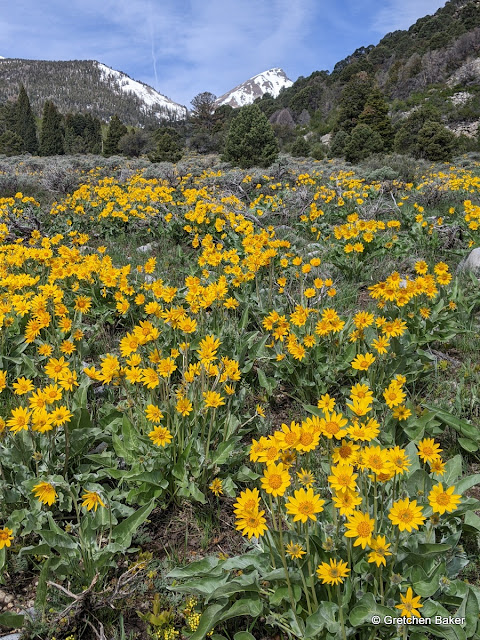With the amazing snow we had this past winter, we knew the wildflowers would be good. We just didn't know how good they would be! The Arrowleaf Balsamroot (Balsamorhiza saggita) was amazing up Baker Creek.
The contrast with the snow on the mountains made the colors pop even more!
I love seeing cactus bloom, as the delicate flowers make such an interesting contrast with the spiky spines. Here's Pediocactus simpsonii, and I have to admit that I know it by it's scientific name and not it's common name. But I looked up the common name for you, and here's what I found: Simpson’s Footcactus, Mountain Ball Cactus, Simpson´s Hedgehog Cactus, Snowball Pediocactus. So there are plenty of common names to choose from!
The bluebells are numerous and especially pretty after a rain.
I think this is Engelmann''s Hedgehog Cactus (Echinocereus engelmannii). So beautiful on a cloudy day.
The superbloom of Arrowleaf Balsamroot was also found in part of the burned area on the Osceola Ditch Trail.
The Arrowleaf Balsamroot also decorated Strawberry Creek.
A friend shared a Facebook post about an unusual flower in Spring Valley. I was intrigued and investigated and found it to be Toano Milkvetch, which has a limited distribution. Nevertheless, it was easy to find in 2023 along the sides of the highway!
Most milkvetch grows low to the ground, but Toano Milkvetch gets over a meter high!
The white verion of Toano Milkvetch! You can even see the highway in this photo.
Up in the meadow in South Fork Baker Creek, the shooting stars are amazing in early July.
Groundsels are blooming well, but what really caught my attention were the aphids, the oval dark insects on the plant. They are true bugs (Hemiptera), and I'm organizing the Hemiptera BioBlitz at Great Basin National Park August 15-17, so paying extra attention to them. About 5,000 species of aphids are known, with several hundred recognized as pests. Some are specialists, only feeding on one species of plant, while others are generalists. What I find is cool is that the aphids such sap out of the plant, making honeydew. Ants have a mutualist relationship with the aphids, climbing up the plant to suck the honeydew (free lunch!) and protecting the aphids from predators.
One more superbloom photo to close out this post. I am trying to put more of my flower and insect photos on iNaturalist, especially since the timing of some of these flowers is so late this year. It's great to record the phenology (timing) of the plants so we know how they can vary. I hope you have been able to see some beautiful flowers this summer!





































1 comment:
Very beautiful, thanks! I'm sure they look extra beautiful to you since you are used to the dry desert most of the time.
Post a Comment